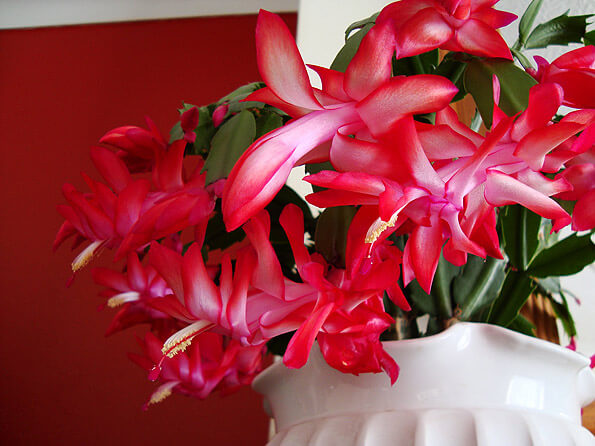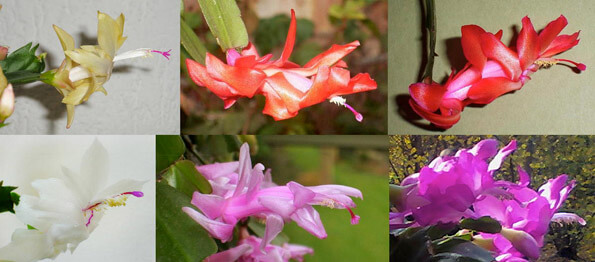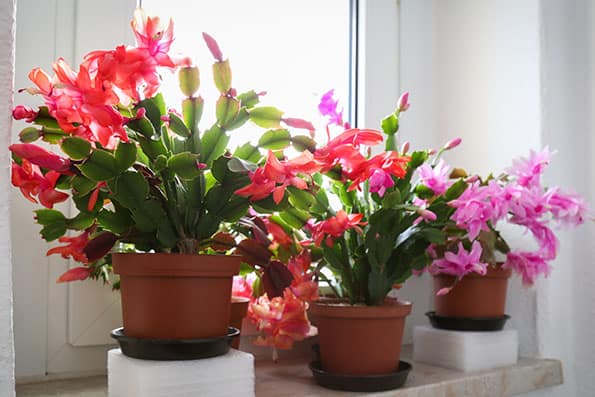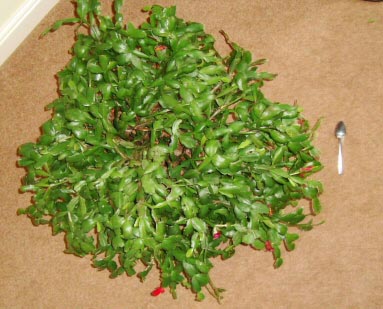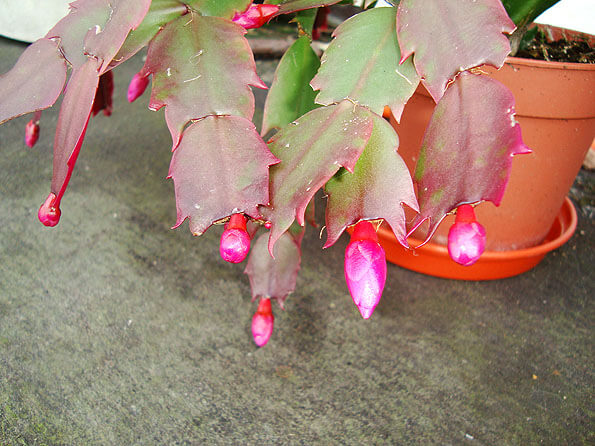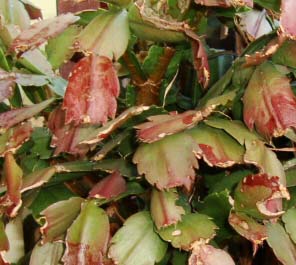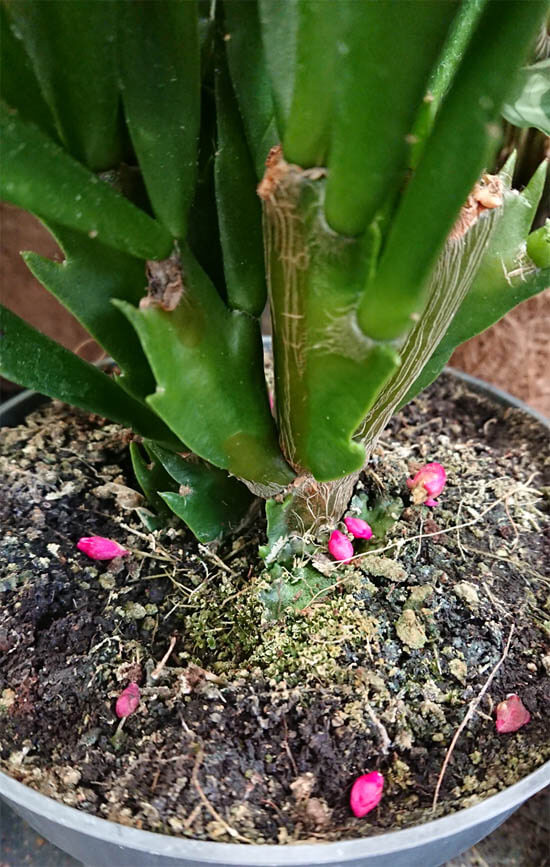Let's just take a moment to look at the scientific botanical name of the Christmas Cactus - Schlumbergera x Buckleyi. No wonder almost everyone who comes across this houseplant just calls it the "Christmas Cactus" or "Thanksgiving Cactus".
A Christmas Cactus in full flower just in time for the holiday season
And if you have come across this plant or its cousin the Easter Cactus (with an equally difficult to say scientific name we might add) in flower, you won't forget either of them in a hurry. With their attention grabbing large and vibrant, but elegant, flowers they leave a lasting impression.
These houseplants come into their own during October, November (Thanksgiving) or in December (Christmas) which is when they normally bloom. The flowering period is also the reason for its common names, however for most of the year, these plants look quite plain.
Naming Information - The Christmas Cactus is Schlumbergera x buckleyi and it's a cross between Schlumbergera truncata and Schlumbergera russelliana. The Thanksgiving Cactus are all cultivars of Schlumbergera truncata.
There aren't a great many varieties available, in fact, you're only likely to find these plants labeled as Schlumbergera truncata or Schlumbergera x buckleyi. The major difference between the two is the shape of the leaves and the shape of the flowers, and even that's only a small difference at best. If you need some help telling them apart have a look at this.
However there are many cultivars and hybrids you can buy. Meaning the number of different flower colours is quite extreme and the number available is always increasing. There will surely be a complementary Christmas Cactus out there for you, no matter the colour scheme of your home.
They're easy to propagate and grow moderately fast. All of this means these are not expensive houseplants to buy and are very common to find in stores during October through to the end of January.
Six different Christmas Cactus Cultivars - Photo by Tangopaso
Although these plants are forest cacti rather than desert cacti, it's easy to see similar elements of their distant sun-loving cousins in their design. The leaves are thick chunky segments all in a long chain radiating from the plant's center which, like all succulents, have the ability to store water in times of drought.
However these Cacti are not adapted for desert life and to do well need much less direct sunlight and more frequent watering than their distant relatives. Fortunately our homes provide perfect growing opportunities and there is no reason you can't have one of these plants living happily for several decades.
We listed the houseplant in the intermediate difficulty section not because it's difficult to grow (it's actually a very forgiving indoor plant), but getting the flowers to return on mass each year needs a little finesse. Don't be intimidated though, we will provide the secrets of success and get you enjoying the sometimes elusive flowers for years to come.

Hi, I'm Tom!
If you're like me and enjoy the challenge of growing houseplants and getting them to thrive, then Ourhouseplants can help. This website shares my knowledge and years of growing plants and provides (hopefully) helpful advice on properly caring for your indoor plant friends.
Unlike desert cacti, the Christmas Cactus grows natively in shady forests. This means direct harsh sunlight needs to be avoided otherwise the leaves will take on a reddish almost damaged looking hue. They need a well lit spot, although they will take darker locations as long as they can be given brighter light for at least a few months of the year.
Unusually for cacti - direct harsh sunlight needs to be avoided
Like all cacti, they can store water inside their thick fleshy leaves, and live off this in emergencies. However if you want a thriving specimen you will need to water as you would a normal houseplant, i.e. when the soil becomes dry.
Water your plant well and then wait until the top inch or so of the soil has fully dried out before you water it again. I've personally never had one of these plants succumb from overwatering, so they do seem fairly resistant to root rot, but I would still strongly recommend not overdoing the watering just in case.
Their annual display more than makes up for the care needs over the year. - Photo by Maja Dumat
Many owners will swear by misting the leaves a few times a month. They do naturally come from shady, dank and moisture heavy forests so this makes sense. However in most modern homes the average humidity in rooms is perfectly acceptable to these plants.
Pro Tip - Do not mist or put your Christmas Cactus in a very humid location if it's in flower or you'll risk making the blooms going soggy and rotting away.
I live in a standard home so have personally never found misting for humidity reasons to be necessary. Although I do mist semi frequently in order to keep the leaves clean from dust, which over time will attract quite a lot of it!
Feed during the growing season (Spring, Summer and early Autumn) about once a month. If it's possible feed with a tomato feed, because this is high in Potassium and should help to encourage a large number of blooms to form. If this isn't practical, an all purpose houseplant fertiliser will be fine.
The average temperatures in most homes is perfect. The plant needs to rest after it has flowered and this needs to be at a slightly cooler temperature of around, 7°C - 16°C (45°F - 61°F). An unheated room would usually be ideal. Avoid anything close to sub-zero.
The Christmas Cactus grows slowly and it takes quite a while to become pot bound (years and years!). Repot after flowering if needed, but you probably won't have to do it more than once every three years or so.
When you decide it's time to repot it, just use a similar potting mix to what it's already growing in. This should be something fairly "open" such as normal potting compost or something labeled for cactus plants and succulents. The root system tends to be quite basic and not overly vigorous so if you're also replacing the growing container, select a pot just slightly bigger than it's previous one.
In Spring or Summer cut off part of one of the stems with 2 or 3 "segments" attached. Wait a day for the cut to dry over before inserting it into a pot with compost. You can use a rooting hormone if you prefer but cuttings normally take easily on their own.
Pro Tip - Individual cuttings by themselves in separate pots will take far too long to become a bushy and an impactful plant. Lots of cuttings will speed this process up. So when propagating always take several cuttings and put them all in the same pot.
Don't go crazy with the watering and aim to keep the compost only slightly moist (too much and the cuttings will rot). Keep things damp for the next month or so and before long roots should have formed and small new leaves should be starting to grow at the leave tips. It will be at least a year or two before your plant is big enough for it to produce flowers.
These plants are fairly slow growing as houseplants. However they will still grow at a fair pace if the conditions are good and you'll notice lots of new light green growth over a growing season.
Slow and steady - eventually even the smallest plant will become a giant in time (Teaspoon on the right for scale)
There is no denying that the Christmas Cactus is a slow growing plant, but over many years it can become quite spread, and heavy! (See picture above, this one is now around 25 years old. Shown next to a teaspoon for scale).
The easy secret to masses of blooms years after year is to move it outdoors.
When in bloom this plant is truly spectacular! You may get one or two flowers if you leave it in the same place all year round, however the simple secret to masses of blooms is to move it - outdoors.
At some point between late May through to early August put the plant outside in a shady protected location. In short, exposure to the elements outdoors hardens up the new growth that will start to form from Spring that year. If kept indoors the new growth stays quite soft and flowers rarely form, exposure to the great outdoors over a couple of months hardens the plant up.
If you don't have access to an outside space, you could try growing it next to a window that is frequently open.
Your Christmas Cactus will flower year after year with the right care (and a period outside)
Buds appear at the very end of each stem after a few months of being outside, but it will take another month or so before they are fully developed. Ideally, when the largest bud looks close to opening, bring the plant indoors to its flowering location and do not move it again until flowering has finished. This is because they dislike being moved about when in flower and doing so runs the risk of bud blast.
Pro Tip - When you put the plant outside for the Summer guard against slugs and snails, which will take random bites out of the segments.
The plant should be brought inside when buds are forming or outdoor night time temperatures approach 7°C / 45°F, whichever comes first. (The Easter Cactus needs to come in when it starts getting cold outside regardless because it won't show buds until early the following year).
Although the leaves and flowers do not taste nice at all, the plant itself is not toxic to people, cats or dogs.
There are three closely related Forest Cacti you can easily buy. The Thanksgiving Cactus, the Christmas Cactus and the Easter Cactus.
Although the Easter Cactus is very distinct and easier to tell apart, the Thanksgiving and Christmas cactus are actually very similar looking. In most parts of the world they're even sold as the same plant. Typically being labeled as the Christmas Cactus. This is simply because the majority of the world do not celebrate "Thanksgiving" and so the name doesn't have as much impact from a marketing point of view.
The consequence of this is that a lot of people don't have a true Christmas Cactus and actually have a Thanksgiving Cactus instead (or the other way around of course!). It's no big deal, as the care requirements are the same, but they do flower at different times and have slightly different looking flower shapes.
Fantastic video explaining how to tell the difference between a Christmas Cactus and Thanksgiving Cactus
If you want to see the differences and get a good understanding of this, then this quick Youtube Video by Desert Plants of Avalon above, explains things so clearly, by the end of it you'll never be confused again.
Moderate Light Needed No intense direct sunlight and avoid low light areas.
Average Watering Expect to water once a week (or less) for most growing locations. Better to be underwatered than overwatered.
Average Temperature Provide temperatures at or above 7°C - 16°C (45°F - 61°F) for best results.
Feeding Feed the soil once a month during Spring and Summer.
Leaves have red edges / entire segments have gone red
Your Christmas Cactus has been exposed to direct sunlight for a prolonged period. To protect themselves, plants create red/purple pigments called anthocyanins. Exposure to powerful light, particularly UV, stimulates this production. The anthocyanins then absorb excessive light energy, working like a natural sunscreen to prevent damage to the plant's cells.
Christmas Cactus showing damage caused by too much sun, and holes from slugs / snails.
Ideally you should move it to a darker spot. Some of the redness will fade over time, but some may remain. If only a few leaves are affected and you don't like the look you can trim them away.
Holes in the leaves
Caused by Slugs or snails! Guard against them when outside and when you bring the pot back into your home, check none are hiding inside among the leaves or underneath the container itself.
Wrinkled Leaves
This will happen in two situations. One is if the plant has been overwatered and the other if it's underwatered. I understand this is likely not overly helpful in terms of your diagnosis. All you can do if feel the root ball and make an educated guess as to what's happened.
Flowering before Christmas (December)
The bud forming process takes just a few months, if you put the Christmas Cactus outdoors in very early June the process will be complete long before December. If you must have flowers for Christmas day, hold off putting outside until August (however avoid early frost at all costs).
You might also have a Thanksgiving Cactus (Schlumbergera truncata) - These plants flower earlier than Christmas and will normally produce their blooms in October and November. Check out this section above to learn more about this.
Bud drop / bud blast on Christmas Cactus
Seeing flowering buds forming on the ends of the leaves is normally a fantastic sight. But sometimes the buds fall off before they have the chance to become normal flowers as shown below.
If flower buds start to form and then fall off like this, it's known as "bud blast"
Bud Blast is when flower buds fail to develop fully and instead the plant gives up and causes them to fall off instead. It's quite common in certain plants including the Christmas, Thanksgiving and Easter Cactus houseplants.
To try and prevent this happening once the buds have started forming you need to move it to a location where it can remain until flowering has finished. If you move it around in the later stages of the bud formation, often they will simply drop off.
Plants may also abandon the flowering attempt if they've run out of water, so ensure you keep the soil moist.
No flower buds
See the flowering section above for the secret. Other causes may be that the plant is too young, too old or the soil is depleted of nutrients. Repot / fertilise or propagate to create new plants.
(Gallery) Photo credit of the Christmas Cactus plant in a Kitchen Empereur Day
